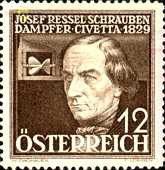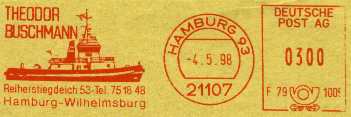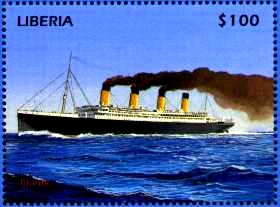|

|
Maritime Topics On Stamps :
Screw Driven Ships and further Developments
development of steam-shipping, part II.
| |
shipbuilding today
|

|

| |
The Greek mathematician Archimedes lived from 285 to 212 B.C.. He
developed the 'Archimedian Screw'. It was a spiral in a screw-shaped
tunnel. This screw marks the beginning in the development of the ship
propeller (topic left). In the 18th century many projects, plans and tests were
conducted in England, France and America, but they all failed.
Eventually the first steamers were constructed with paddles. But two
men continued the experiments: the Austrian Joseph Ressel (stamp right) and the
British Francis Petitt Smith. From 1812 to 1826 Ressel built a working
propeller and in 1839 Smith developed a screw which was actually
installed on the steamer 'Archimedes'.
|

|

| |
The Swedish engineer John Ericsson achieved a major breakthrough in
screw development. He built three test ships in short succession in
England. The last one was named 'Robert F. Stockton' and reached 13
knots during a test trip on the river Thames in the year 1838. In 1839
Ericsson sailed to America with the same ship within 40 days. It was
the first journey across the Atlantic with a screw-driven ship. The ship continued to serve
under the name 'New Jersey' for a long time afterwards on the
Delaware-Raritan Channel. Later on Ericsson built two man-of-wars in America,
the 'Princeton' and the 'Monitor'.
|
|
The Cunard liners 'Persia' and 'Scotia' were the
last fast steamers with paddle-wheels on the North-Atlantic (1856 to
1872). Then the screw-driven ships followed. The White Star Line build
the 'Adriatic', the 'Britannic' and the 'Germanic'. The Inman Line
build the 'City of Brussels' and the 'City of Berlin' (see stamp). The
engine of the 'City of Berlin' reached 3200 HP. Using one screw the
ship made 14 knots and won the famous 'Blue Riband' in 1875. The
length was 520ft, beam 44ft, BRT 5491. In 1879 the steamer was the
first ship to be equipped with an
electric cabin lights system.
|

|

|
In 1888 the'City of New York' and her sistership 'City of Paris'
(stamp) were build for the Inman Line. They became the first double-screw fast liners of
the world. They crossed the Atlantic in six days at an average speed
of 20 knots. Both won the 'Blue Riband' shortly thereafter. The
measurements: length 556ft, beam 62ft, BRT 10499, HP 18500, three
funnels, 1740 passengers in three classes.
|
|
The Danish cargo ship 'Selandia' was build in 1912. She was the first sea-going motor vessel of the
world. On her maiden voyage to Japan she sailed for 22000 miles
without problems. The ship was owned by the Danish East Asiatic
Company, which believed in the superiority of the Diesel motor over
the classic steam engine. The 'Selandia' was equipped with two
four-cycle Diesel engines with 1250 HP each and two screws. Her average
speed reached 11 to 12 knots. The length 384ft, beam 52.5ft, draft 29.5ft, BRT
4964, built at the dock-yards of Burmeister and Wain, Copenhagen.
Note: the ship had no real funnel, only an exhaust pipe at the mast.
|

|

|
The American 'United States' was the fastest non-
military vessel of the world. In 1951 she was
build as a passenger liner (2000 passengers), but could be used as a
troop carrier (14000 soldiers). She sported four steam gear-turbines
with 27000 HP. Using all four screws she could reach a maximum speed
of 42 knots, although the standard official cruising speed was 'only'
36 knots. In 1952 the 'United States' won the 'Blue Riband' and holds
the record up to today (for single hull vessels). Her fastest Atlantic
passage took 3 days, 10 hours and 40 minutes from Ambrose lightship to
Bishop Rock lighthouse.
| |
Some measurements: Length 991ft, beam 102ft,
draft 36ft, BRT 53329, 16 decks. The whole interior was made of
inflammable material. In 1969 the ship was docked and she temporarily
served as a hospital ship. Eventually the 'United States' was sold to
a cruise line company in 1981.
|
|
'Atomic' driven ships have a nuclear reactor to
produce the steam for the turbines. The American submarine 'Nautilus'
was the first nuclear powered vessel of the world. In 1954 construction had been finished.
Nuclear reactors don't need oxygen, so they are an obvious choice for
submarines allowing them to travel under the surface with high speed
(30kn) for a very long time. The 'Nautilus' even dived beneath the
mighty ice of the North Pole (see stamp). Today many submarines and
ice breaker ships use a nuclear powered drive, although they never paid off
when fitted to merchant ships (e.g. 'Savannah', 'Mutsu', 'Otto Hahn').
|

| |
See our page about the
three merchant nuclear freighters!
|

|

| |
As we all know 'Time is money.' and scientists try all possible and
impossible things to raise the speed. This applies to shipping as
well. To the left you can see a hydrofoil boat. Because of the form of
the hydrofoil the currents have the same effect as on an aeroplane. At
a certain angle and speed a vacuum arises which partly lifts the boat
out of the water. This vacuum greatly reduces friction and thus,
increases speed. It is the same effect as with the double hull boats,
the so-called catamarans. The total surface below the waterline is
greatly reduced than a normal single hull boat. As with the hydrofoil
boats this results in less friction and higher speeds.
|

|

| |
The Voith-Schneider propulsion
was developed in 1929 by the Austrian Ernst Schneider and the company
Voith. The drive itself consists of four to six propeller wings,
mounted on a rotating disc. The wings do swinging movements to achieve
the propulsion. The placement on the ship allows to steer the boat
with the drives alone. It is even possible to rotate the whole ship on
the spot. A lot of modern tugs (i.e. in the port of Hamburg) use this
drive today. The propellers are mounted under the focsle to get a
better hawser pull. Some even have two Voith- Schneider propulsions,
fore and aft.
|

|
A hovercraft (aircraft boat) is sliding on a compressed air pillow above the water
surface. Many controversies arose whether to classify it as an
aeroplane or a ship. Among the most famous inventors were the Swedish
Carl Gustav de Laval (1883) and the Brtish Cristopher S. Cockerill
(1950). The two boats built at the British Hovercraft Corporation are
the largest hovercrafts in the world. The 'ships' with a length of
179ft can travel at a speed of 150 kph and transport up to 416
passengers and 55 cars. Today they serve as ferryboats on the English
Channel (up to Oct. 2000, then out of duty).
Over 100 different types in more than 20 countries are used
for passenger transportation.
|

| |
The latest development in shipping drives is the 'Azipod (Azimuth
Podded Drive) Electric Propulsion Drive'. The propulsion unit looks
like a small gondela hanging beneath the stern of the vessel,
containing a powerful electric engine and the propeller. The pod can
be rotated a full 360 degrees and works as a steering unit as well.
Traditional rudders, stern thrusters, propeller-shaft and shaft
tunnels become obsolete. The small engine room contains only the
diesel generators to provide electric power. Noise, vibrations and
weight are reduced to a minimum. Additionally the unused space can be
used to increase cargo capacity.
| |
The Azipod system has been jointly developed by Kvaener Masa-Yards
and ABB Industry of Finnland. The Azipod already is the engine of
choice for cruise liners of the Carnival Cruise Lines and the Royal
Caribbean Cruise and even for some ice-breakers. The silhouette on the
stamp above shows the new 'Europa' of Hapag Lloyd, finished in 1999.
At the stern you can spot the Azipod gondela. Two Azipod units are
installed, each sporting a power of 14 MW. They enable the'Europa' to
push its 28600 BRZ to an average speed of 21 knots.
In the meantime the companies Siemens and Schottel have developed their
'Siemens-Schottel-Propulsor'. There are two propellers at the gondela.
|

|

|
We all know the famous 'Cable Car' in San Francisco. A similar technic
was used on the European rivers. The cable cars cling to a running
cable. The 'chain steamers' pull themselves up-stream along a fixed
chain lying on the ground of a river instead. The chain was moved by a
heavy winch powered by a steam engine. From 1866 to 1892 a lot of
different companies operated on the river Elbe (Germany) using
chain steamers. In shallow or driftage-heavy rivers these ships were
superior to the more commonly known paddle- and screw-steamers.
|
|
A stamp with the passenger liner 'Titanic'. Her engines had a power of 46000 HP
and with three screws she reached a speed of 23 to 24 knots.
See our page about the 'Titanic' desaster!
|

|
|